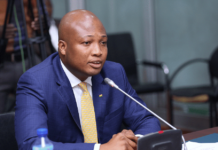
There is a massive infrastructural development across Europe, Asia and America which gives a clear indication of the conscious efforts made by leadership of these continents to ensure sustained developments there. The story is quite different in Ghana and across Sub-Saharan Africa. Although we see some infrastructural development on our continent, there is still room for improvement.
Recently, I joined other colleagues on a seminar organised by UK Chamber of Commerce (UKGCC) to discuss project financing and its associated implication on the bigger economy. This piece is inspired by insightful discussions we had at the event. Thanks to Steven Gray, Director at Wardour Global Limited and UKGCC for organisation that impacting event.
Ghana Infrastructure Plan (2018-2047) Sector Overview
Currently, it is estimated that Ghana`s Infrastructure plan up to 2047 requires a total investment of $331bn where $128.8bn is required for Transportation, $17.6bn for Water & Drainage, $900m for Waste Management and $168bn for Housing & Energy Sector. This makes Project Finance a more attractive financing option as compared to the traditional way of funding. I strongly believe this will help the country to offset the infrastructural deficit because project finance provides limited recourse to sponsors among other merits.
Information Communication & Technology (ICT) Sector
Ghana has the second-highest data penetration rate in sub-Saharan Africa, the fastest-growing mobile money market on the continent and a burgeoning tech start-up scene. ICT therefore represents one of the most dynamic areas of the economy. Recognising the sector’s potential, the government has stepped up efforts to stimulate market activity.
More and more commercial transactions are moving online, and the so-called digital economy continues to expand its reach into every facet of the traditional analogue economy. For businesses this means they have access to new channels to reach existing clients as well as new opportunities to expand market share with a competitive digital.
The ICT infrastructure provision therefore requires huge capital expenditure for initial set up and maintenance. The global trend for alternative funding besides government is Public Private Partnership (PPP), Private Equity, Loans etc and indeed PPP remains the most popular option to bridge this gap. To meet 100% internet penetration rate by 2047, it is pertinent that we consider the drastic approach of project finance as a financing approach.
Transportation
Everybody requires a means of transport every day. The transport sector is an important industry sector in the economy and largely deals with the movement of people and products. The sector includes companies such as airlines, trucking, railroads, shipping, and logistics firms, as well as those that provide transportation infrastructure. Aayololo – Bus Rapid Transit System, was inaugurated on the 25th of November 2016, in Ghana, which is operational in Accra but today, the least said about that transit system, the better. Efficiency is required to change the transport sector. Total Investment required in the Transportation sector by 2047 is estimated at $331bn. This also covers expansion of airports to the regions, additional expansion at Tema and Takoradi port and on the Volta Lake. The ambition is to add 4000km of standard gauge railway network. Project financing is a sure way of meeting this target.
Housing
There is a huge housing deficit in Ghana and accommodation remains a major challenge to many Ghanaians. No wonder successive Governments have made it a priority to set up the affordable housing scheme aimed at addressing the gap. The cost of an affordable house in Ghana ranges from GHS100,000(USD18,000) to GHS200,000 (USD40,000), taking into consideration people’s incomes and the feasibility of the construction costs. A house is only affordable when people have the money to buy, or can access a mortgage to buy, the property.
In fact, total investment required for housing is estimated at $900bn and about 8.4m houses are required from 2018 – 2047. This therefore requires the need to develop alternatives to inputs to meet the housing sector deficits.
Water and Drainage System.
The rains continue to set in. The development of a well-planned and good quality, urban settlement requires adequate infrastructure provided. Drainage systems, water and sewerage connections are among the important infrastructure services which need to be provided.
Total investments required to address the water & Drainage system is estimated at $128.8bn. New water required is about 48bnm3 by 2047 and hence it is important to focus our energy on water resource management. There is the need for 204 new peri-urban systems planned and upgrade on 171 systems. Seven (7) new urban water systems planned, and upgrades required on 42 systems. There is also the need to improve the irrigation systems to cover over 823,000 hectors of farmlands to improve production.
Energy
The World Energy Council’s Energy Trilemma Index ranks Ghana among the top 10 countries that have improved on energy security, equity and environmental sustainability. Only two other African countries – Kenya and Ethiopia – made the top 10. The shift from hydro to thermal has helped Ghana to increase energy security. The total installed capacity for existing plants in Ghana is around 4,132 Megawatt (MW), consisting of hydro 38%; thermal 61%; and solar less than 1%.
However, one of Ghana’s paramount constraints to economic growth is the unreliable and inadequate supply of electric power. It is estimated that about $168bn is required to address the Energy sector challenge by 2047. This should potentially see increase in generating capacity from 4.1MW to about 50.2MW, with focus on loss reduction technology.
There are several approaches to finances the above infrastructure-whether through Public or Private Approach. I believe leveraging on Private Project Finance options would see some of the projects becoming a reality.
Why Project Finance
I strongly believe there are several reasons why project Financing is an attractive option that needs to be considered to bridge gap because.
1.It provides limited recourse to the sponsor. The lender`s recourse is only to the project, its cash flows and contrast. Again, it provides the sponsors the increased ability to finance large capital projects.
2.Off-Balance sheet treatment. This is so because non-recourse debt often receives off-balance sheet treatment and all equity analysts will typically exclude project debt from gearing calculations of sponsor parent companies and
3.High leverage is available, there is also the availability for long tenors compared to corporate debts.
Basically, what Project Finance does is that it raises funds for independent projects and allows for limited recourse to project sponsors. What this means is that debt raised to finance the project is secured only by Project Company`s cash flows and usually ring-fenced in a special purpose vehicle (SPV) which then becomes the project’s company. In effect if the project is unable to meet its debt obligations, the lenders cannot pursue the sponsor for the payment though the sponsor may need to provide some form of credit support until the asset is complete. It is noteworthy that repayments on project debts are serviced purely on the cash flows. The credits are driven by the characteristics of the projects rather than the credit of the sponsor.

Project Finance and Corporate Finance- are there differences
More often than not, a lot of finance professionals are tempted to believe that Project Finance is the same as Corporate Finance. There may be some similarities, but the distinction is so clear. I think it’s important to address the misconception. Some of the differences are highlighted below:
In spite of above, it is important to highlight that it is not the case that project finance is always the best option when it comes to financing infrastructure. Sometimes, small value projects that may estimate less than USD40m may not best fit as the cost of preparations is high and may not be attractive or viable from a financial returns point of view.

Also, financial engineering benefits may not be attainable in all circumstances. Depending on the final risk allocation, structured finance debt can be more expensive than corporate debt.
Risk to consider
Getting the right projects financed requires a thorough job done on risk. Usually the underlying risk in financing projects is expressed by way of credit ratings which look at the risk in terms of both the qualitative and quantity aspects through a structured framework. It is always important to consider market risk, Political/regulatory risk, completion risk, force majeure, operational risk, environmental and social impact
Conclusion
To undertake any project financing activity for the above infrastructural development, there must be compelling need for the project to ensure that the process becomes successful. For example, a creditable consultant must perform extensive due diligence and develop the finance structure. Ensure proper scrutiny of uncontrollable factors that may hinder the success of the project.
There must also be a proven technology as technical failures can severely delay completion. All problems that may be encountered during the project may cause significant financial damage. Again, more importantly, where there is the need to have interventions, there should be acceptable sovereign risk. Government must provide support if necessary. Together we built a better Ghana for yet unborn generations. Disclaimer: The views expressed are personal views and doesn’t represent that of the media house or institution the writer works
Credit: UK Chamber of Commerce, Miriam Amoako
About the writer
Carl is a Finance and Investment professional, managing Global Subsidiaries and Financial Institution`s relationships with an International Bank in Sierra Leone.
Contact: Carl.odamegyenti@gmail.com, Cell: +232 33240 467


























